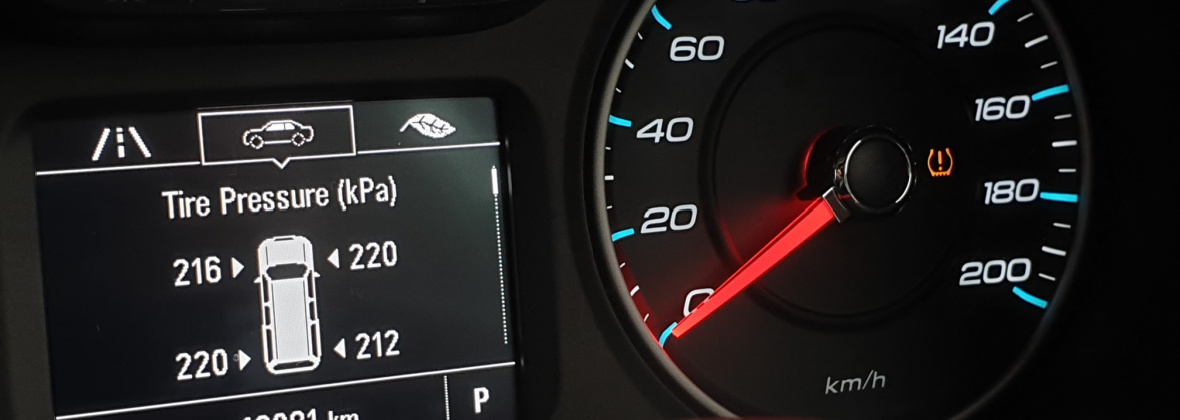How Does a Tire Pressure Monitor System Work?
October 20, 2022

In this blog post, we’ll explore how a TPMS works and what you can do to maintain your tires’ ideal pressure levels.
Introduction
A tire pressure monitor system, or TPMS, is an electronic system designed to monitor the air pressure in a vehicle’s tires. TPMS sensors are mounted inside the tires, and the data is transmitted to a receiver mounted on the vehicle. The receiver then displays the information on a dash-mounted readout.
The benefits of TPMS are twofold. First, it can help improve fuel economy by maintaining proper tire inflation levels. Second, it can help improve safety by alerting the driver to a sudden drop in tire pressure.
There are two types of TPMS systems: direct and indirect. Direct TPMS systems have sensors that measure the air pressure inside the tires and transmit that information to the receiver. Indirect TPMS systems do not have sensors; they use the vehicle’s speed sensors to estimate the air pressure inside the tires.
Most new vehicles come equipped with direct TPMS systems, while older vehicles usually have indirect TPMS systems.
What is TPMS?
A Tire Pressure Monitor System (TPMS) is an electronic system that monitors the air pressure in a vehicle’s tires. The TPMS sensors are mounted on the wheels and measure the tire pressure. The TPMS light is located on the dashboard and is used to indicate when the tire pressure is low. The TPMS system can be used to inflate the tires when the pressure is low.
What is a Tire Pressure Gauge?
A tire pressure gauge is a small, hand-held tool that is used to measure the air pressure in a tire. Most commonly, tire pressure gauges are used to check the pressure of car or bicycle tires. However, they can also be used on other types of tires, such as those on motorcycles, RVs, and trucks.
There are two types of tire pressure gauges: digital and analog. Digital tire pressure gauges are more accurate than analog ones, but they are also more expensive. Analog tire pressure gauges are less accurate but are cheaper and easier to use.
To use a tire pressure gauge, first, unscrew the valve cap from the valve stem on the tire. Then, hold the gauge firmly against the valve stem and press the button to release air from the gauge. The gauge will start to fill with air from the tire. once the needle on the gauge stops moving, that is your tire’s air pressure reading.
It is important to check your tires’ air pressure regularly to ensure optimal performance and safety while driving. Tires that are underinflated can lead to reduced fuel efficiency and increased wear and tear on the tires. On the other hand, tires that are overinflated can burst or blow out while in use.
What is a TPMS Sensor?
A TPMS sensor is a small electronic device that is installed in each tire of a vehicle. The sensor monitors the air pressure in the tire and sends a signal to the TPMS system when the pressure falls below a certain level. The TPMS system then displays a warning light on the dash, letting the driver know that the tire pressure is low and needs to be checked.
There are two types of TPMS sensors: direct and indirect. Direct TPMS sensors measure the air pressure in the tire and send a signal to the TPMS system. Indirect TPMS sensors measure the speed at which the tire is rotating and send a signal to the TPMS system when the speed falls below a certain level. This type of sensor is less accurate than a direct sensor, but it does not require batteries so it is less expensive to maintain.
Most new vehicles come equipped with direct TPMS sensors, but some still use indirect TPMS sensors. If you are not sure which type of sensor your vehicle has, consult your owner’s manual or ask your mechanic.
What is a TPMS Light?
A TPMS light is a warning light that illuminates the dashboard of a vehicle to indicate that there is an issue with the tire pressure. The light will usually be accompanied by a message telling the driver to check the tire pressure. The purpose of the TPMS light is to alert the driver that there is an issue with the tire pressure so that they can take action to fix it.
There are two primary types of TPMS systems: direct and indirect. Direct TPMS systems have sensors that are installed in each wheel and measure the tire pressure directly. Indirect TPMS systems do not have sensors in each wheel and instead use the vehicle’s speed sensor to calculate the tire pressure.
TPMS sensors can go bad over time and will need to be replaced. If a TPMS light illuminates the dashboard, it is important to take action to fix the issue so that you can avoid getting a flat tire or having an accident.
How Does TPMS Work?
A Tire Pressure Monitor System (TPMS) is an electronic system that monitors the air pressure in your tires. This system uses sensors that are mounted on each tire and wheel assembly to check the air pressure in your tires. If the air pressure in one or more of your tires is low, the TPMS sensor will send a signal to the TPMS light on your dash, which will then turn on.
How Does a Tire Pressure Gauge Work?
A tire pressure gauge is a simple device that measures the air pressure in your tires. It’s a handy tool to have in your car or garage, and it can be used to check the pressure of all four tires at once.
TPMS, or Tire Pressure Monitoring System, is a feature that is now available on many newer cars. This system uses sensors to monitor the air pressure in your tires and will give you a warning if the pressure gets too low. Some TPMS systems will also adjust the inflation of your tires automatically to keep them at the correct pressure.
How Does a TPMS Sensor Work?
Tire pressure monitoring systems (TPMS) are designed to notify the driver when a tire is significantly under-inflated. By constantly monitoring the air pressure in each tire, TPMS can help improve fuel economy, increase tire life, and maintain vehicle handling and safety. Here’s a look at how TPMS works:
A TPMS sensor is mounted on each wheel and inflated to the specified pressure for that particular vehicle. The sensor monitors the air pressure in the tire and transmits that information to a receiver mounted on the vehicle. If the air pressure in one or more tires falls below a preset threshold, the TPMS system will activate a warning light on the dash to alert the driver.
In some cases, the system may also provide an audible or visual alert outside of the vehicle. Most TPMS systems will also provide information on which tire is low on air so that the driver can take action to inflate it to the proper level.
Not all vehicles are equipped with TPMS, but many newer models do have this feature. If your vehicle does not have TPMS, you can still check your tires manually with a tire pressure gauge.
How Does a TPMS Light Work?
A tire pressure monitor system, or TPMS, is an electronic system that monitors the air pressure in a vehicle’s tires and sends a warning signal to the driver if the pressure gets too low. Most modern TPMS systems use wireless sensors that send data to a receiver mounted on the dashboard. Some systems also include a tire pressure gauge so that the driver can check the pressure in all four tires at once.
The main purpose of a TPMS is to prevent underinflated tires, which can lead to blowouts and other serious problems. Underinflated tires are also much more likely to overheat, which can cause tread separation and loss of control. A TPMS light on the dashboard will usually come on when one or more tires are more than 25% below the recommended inflation level.
There are two types of TPMS sensors: direct and indirect. Direct sensors measure tire pressure and send data directly to the receiver. Indirect sensors use wheel speed and other data to calculate Tire Pressure. Most TPMS systems use indirect sensors because they’re less expensive and easier to install. However, direct sensors are more accurate, so they’re often used in high-end vehicles.
TPMS Benefits
A Tire Pressure Monitoring System (TPMS) is an electronic system that monitors the air pressure inside the pneumatic tires on various types of vehicles. A TPMS reports real-time tire-pressure information to the driver of the vehicle, either via a gauge, a pictogram display, or a simple low-pressure warning light.
Improved Fuel Economy
One of the best benefits of having a TPMS is improved fuel economy. Tires that are properly inflated can help your car’s engine run more efficiently, which in turn can save you money at the pump.
Reduced Tire Wear
Underinflated tires can cause increased tire wear due to the increased rolling resistance. The added friction between the road and the tire creates heat, which breaks down the tire material faster. TPMS systems can help you maintain the proper tire pressure, which can help extend the life of your tires.
Improved Fuel Economy
According to the U.S. Department of Energy, proper tire inflation can improve your gas mileage by up to 3.3%. That means if you fill up your tank once a week, you could save up to $108 per year!
Safer Driving
Underinflated tires are more likely to blow out and cause accidents. They also make it more difficult to control your vehicle, especially in emergency situations. By maintaining proper tire pressure, TPMS systems can help keep you safe on the road.
Enhanced Safety
One of the major benefits of having a TPMS is enhanced safety. Because the system is designed to monitor your tires and alert you when they are low on air, it can help you avoid a blowout or other serious incidents.
If you’re driving along and suddenly get a warning light on your dash that one of your tires is low on air, you’ll know to pull over and address the problem. This can help you avoid getting stranded on the side of the road, or worse, getting into an accident.
Similarly, if you’re driving in cold weather and your TPMS sensor detects that your tires are losing pressure due to the colder temperature, it will warn you so that you can add air and maintain safe tire pressure. This is especially important in winter weather when roads are icy and conditions are generally more hazardous.
Conclusion
A Tire Pressure Monitor System (TPMS) is an electronic system that is designed to monitor the air pressure in a vehicle’s tires and provide the driver with a warning if the pressure is low. There are two types of TPMS: direct and indirect. Direct TPMS uses sensors that are mounted inside the tire to measure the air pressure. Indirect TPMS uses the vehicle’s ABS brakes to estimate the air pressure in the tires.
Most new vehicles sold in the United States are required to have a TPMS system installed. Many newer vehicles also have a tire pressure gauge built into the dashboard that can be used to check the pressure in all four tires at once.
If you have a TPMS light on your dashboard, it means that one or more of your tires is low on air. You should stop driving immediately and check your tires. If you find that one or more of your tires is indeed low on air, add air until it reaches the recommended pressure. If you cannot get the tire pressure to recommended levels, you will need to have the tire repaired or replaced.
Back

